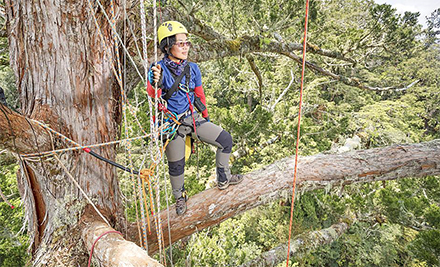
Forestry Research Institute researcher Hsu Chia-chun
Photo courtesy Council of Agriculture Forestry Research Institute
The Council of Agriculture’s Forestry Research Institute in Taiwan has invited the public to participate in a project to map Taiwan’s remaining “giant trees.” A researcher has challenged people to find a tree taller than the current record holder, which is a 79.1m Taiwanese cypress in the mountains of Hsinchu County. Source: Taipei Times
The program, called “Tree Finder,” is a collaboration between the institute and National Cheng Kung University to locate Taiwan’s tallest trees by using lidar technology, institute researcher Hsu Chia-chun said.
“We have lidar scanning equipment on aircraft used in flights over Taiwan’s mountainous regions, as well as used to calibrate the collected data on tree measurements. This has enabled us to identify 272 trees that are more than 65 meters tall, the tallest of which is 79.1 meters,” Ms Hsu said.
The tree, dubbed the “Taoshan sacred tree” is of the indigenous Taiwania cryptomerioides cypress species.
Each preliminary ‘giant tree’ measurement requires thousands of 3D point-cloud data points from lidar, but it still has an error range of about 10 meters. So, field work is needed by our teams to locate the tree and take measurements on site,” Ms Hsu said.
It is really hard work, as most of these [trees] are located in remote areas, and it would take [teams] more than 10 days to just cut the undergrowth to make a trail to reach them.”
Taiwan’s development began relatively late, so it still has well-preserved primary forest stands. This, combined with the nation being in a subtropical zone with high biodiversity, has enabled Taiwan to become the only country in East Asia that still has giant trees in its mountains.
Only a few places in the world have forest stands of more than 70 meters. Taiwan is one of these few places and the only one in East Asia.
Taiwan’s forestry protection has been praised by many foreign scientists.
“Nature is always unpredictable,” Ms Hsu said, adding that she wants to find out if Taiwan has trees taller than 80m, “but cannot be sure about it, as the Taoshan sacred tree could turn out to be the nation’s tallest.”
Her team used forest growth models and applied calculations to identify likely giant trees.
They then removed those located on mountain slopes of more than 70 degrees to come up with 54,415 images that are likely to contain giant trees, she said.
The images would be uploaded to www.no1tree.tw for the public to participate in the program.
“Each image needs to be verified by three people who would visually check the likelihood of trees of more than 65 meters,” Ms Hsu said.
If a candidate is found, forestry teams would take an on-site measurement to verify it as a giant tree.
We will need at least 150,000 people to join the effort,” Ms Hsu added.
She invited people to register on the Web site to help map the distribution of giant trees and “establish the tallest tree in Taiwan.”





